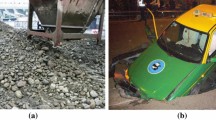Abstract
Artificial ground freezing has been applied to many geotechnical projects as temporary and permanent ground stabilization. This paper presents numerical formulations implemented in SMAP-T2, which is specially designed for geotechnical applications of heat transfer problems, along with a new efficient method to compute average heat capacity at freezing point. As one of the practical applications, a frozen backfilled egress shaft is presented in this paper. The aim of this example is to evaluate time requirements for freezing and maintaining the frozen shaft, to evaluate freezing front migrations and possible insulation schemes, and to assess the relative advantages of various stemming materials such as pure water and combinations of soil/water mixtures.
Similar content being viewed by others
References
Andersland, O. B. and Anderson, D. M. (1978). Geotechnical engineering for cold regions, McGraw-Hill, New York.
Blouin, S. E. and Kim, K. J. (1983). Use of frozen backfill as a combination egress/heat sink system for deep basing, Contract No. DEACO1-82FE60199.
Catton, I. and Edward, D. K. (1967). “Effect of side walls on natural convection between horizontal plates heated from below.” J. Heat Transfer, Vol. 89, No. 1, pp. 295–299.
Comini, G., Del Guidice, S., Lewis, R. W., and Zienkiewicz, O. C. (1974). “Finite element solution of non-linear heat conduction problems with special reference of phase change.” International Journal of Numerical Methods for Engineering, Vol. 8, No. 1, pp. 613–624.
DeVries, D. A. (1952). The thermal conductivity of soil, Translated by Building Research Station, Library Communication No. 759, England.
Dittus, F. W. and Boelter, L. M. K. (1930). Heat transfer in automobile radiators of the tubular type, University of California Publications on Engineering, Berkeley, CA, Vol. 2, No. 13, p. 443.
Donea, J. (1974). “On the accuracy of finite element solutions to the transient heat-conduction equation.” International Journal of Numerical Methods for Engineering, Vol. 8, No. 1, pp. 103–110.
Farouki, O. T. (1981). Thermal properties of soils, CRREL Monograph 81-1.
Harris, J. (1995). Ground freezing in pactice, London, Telford.
Heisler, M. P. (1947). “Temperature charts for induction and constant temperature heating.” Trans, ASME, Vol. 69, No. 1, pp. 227–236.
Heitz, W. L. and Westwater, J. W. (1970). “Extension of the numerical method for melting and freezing problems.” Int. J. Heat Mass Transfer, Vol. 13, No. 1, pp. 1371–1375.
Hsu, T. R. and Pizey, G. (1981). “On the prediction of the fusion rate of ice by finite element analysis.” Journal of Heat Transfer, Vol. 103, pp. 727–732.
Johansen, O. (1977). Thermal conductivity of soils, PhD Thesis, Trondheim, Norway.
Kersten, M. S. (1949). Laboratory research for the determination of the thermal properties of soils, ACFEL Technical Report 23, AD 712516.
Korea Institute of Construction Technology (2009). Development of future construction technology for advancing into siberia frozen ground, Final Report for Ministry of Land, Transport and Maritime Affairs.
Lees, M. (1966). “A linear three-level difference scheme for quasilinear parabolic equations.” Maths. Comp., Vol. 20, No. 1, pp. 516–522.
Luikov, A. V. (1968). Analytical heat diffusion theory, Academic Press, New York.
Somerton, W. H. (1958). “Some thermal characteristics of porous rocks.” Journal of Petroleum Technology, Vol. 12, No. 6, pp. 61–64.
Wolfe, L. M. and Thieme, J. O. (1964). “Physical and thermal properties of frozen soil and ice.” Journal of the Society Petroleum Engineers, Vol. 4, No. 1, pp. 67–72.
Zienkiewicz, O. C. (1971). The finite element method in engineering science, McGraw-Hill, London.
Author information
Authors and Affiliations
Corresponding author
Rights and permissions
About this article
Cite this article
Kim, Y.S., Kang, JM., Lee, J. et al. Finite element modeling and analysis for artificial ground freezing in egress shafts. KSCE J Civ Eng 16, 925–932 (2012). https://doi.org/10.1007/s12205-012-1252-y
Received:
Revised:
Accepted:
Published:
Issue Date:
DOI: https://doi.org/10.1007/s12205-012-1252-y




